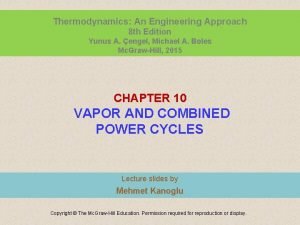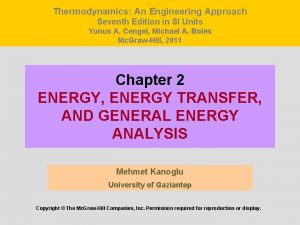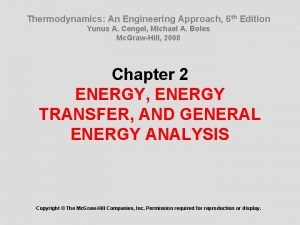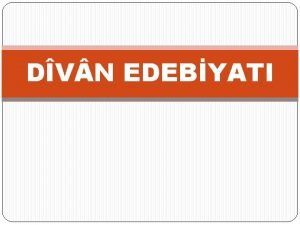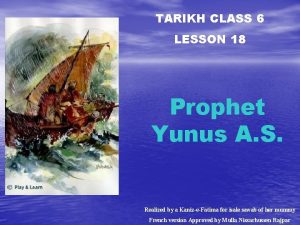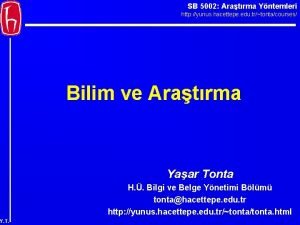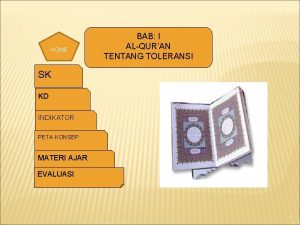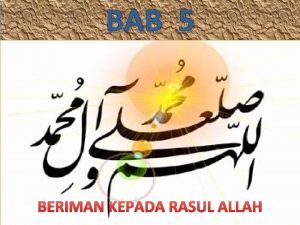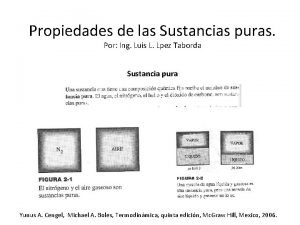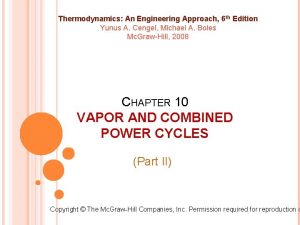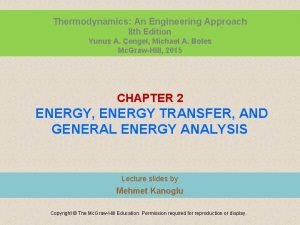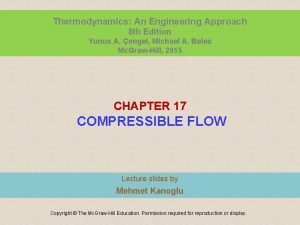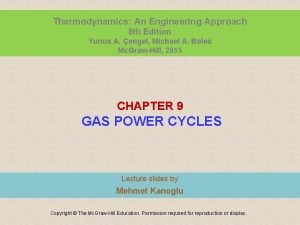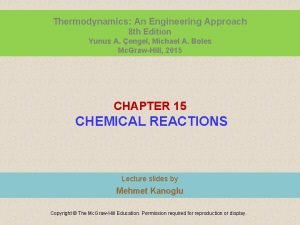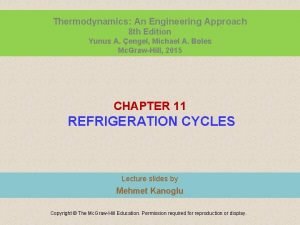Thermodynamics An Engineering Approach 8 th Edition Yunus













- Slides: 13

Thermodynamics: An Engineering Approach 8 th Edition Yunus A. Çengel, Michael A. Boles Mc. Graw-Hill, 2015 CHAPTER 13 GAS MIXTURES Lecture slides by Mehmet Kanoglu Copyright © The Mc. Graw-Hill Education. Permission required for reproduction or display.

Objectives • Develop rules for determining nonreacting gas mixture properties from knowledge of mixture composition and the properties of the individual components. • Define the quantities used to describe the composition of a mixture, such as mass fraction, mole fraction, and volume fraction. • Apply the rules for determining mixture properties to ideal-gas mixtures and real-gas mixtures. • Predict the P-v-T behavior of gas mixtures based on Dalton’s law of additive pressures and Amagat’s law of additive volumes. 2

COMPOSITION OF A GAS MIXTURE: MASS AND MOLE FRACTIONS To determine the properties of a mixture, we need to know the composition of the mixture as well as the properties of the individual components. There are two ways to describe the composition of a mixture: Molar analysis: specifying the number of moles of each component Gravimetric analysis: specifying the mass of each component Mass fraction Mole fraction 3

Apparent (or average) molar mass The sum of the mass and mole fractions of a mixture is equal to 1. Gas constant The molar mass of a mixture Mass and mole fractions of a mixture are related by 4

P-v-T BEHAVIOR OF GAS MIXTURES: IDEAL AND REAL GASES The prediction of the P-v-T behavior of gas mixtures is usually based on two models: Dalton’s law of additive pressures: The pressure of a gas mixture is equal to the sum of the pressures each gas would exert if it existed alone at the mixture temperature and volume. Amagat’s law of additive volumes: The volume of a gas mixture is equal to the sum of the volumes each gas would occupy if it existed alone at the mixture temperature and pressure. 5

Pi component pressure Vi component volume Pi /Pm pressure fraction Vi /Vm volume fraction For ideal gases, Dalton’s and Amagad’s laws are identical and give identical results. 6

Ideal-Gas Mixtures This equation is only valid for ideal-gas mixtures as it is derived by assuming ideal-gas behavior for the gas mixture and each of its components. The quantity yi. Pm is called the partial pressure (identical to the component pressure for ideal gases), and the quantity yi. Vm is called the partial volume (identical to the component volume for ideal gases). Note that for an ideal-gas mixture, the mole fraction, the pressure fraction, and the volume fraction of a component are identical. The composition of an ideal-gas mixture (such as the exhaust gases leaving a combustion chamber) is frequently determined by a volumetric analysis (Orsat Analysis). 7

Compressibility factor Real-Gas Mixtures Kay’s rule Zi is determined either at Tm and Vm Dalton’s law) or at Tm and Pm (Amagat’s law) for each individual gas. Using Dalton’s law gives more accurate results. Zm is determined by using these pseudocritical properties. The result by Kay’s rule is accurate to within about 10% over a wide range of temperatures and pressures. 8

PROPERTIES OF GAS MIXTURES: IDEAL AND REAL GASES Extensive properties of a gas mixture Changes in properties of a gas mixture 9

Extensive properties of a gas mixture Properties per unit mass involve mass fractions (mfi) and properties per unit mole involve mole fractions (yi). The relations are exact for ideal-gas mixtures, and approximate for real-gas mixtures. 10

Ideal-Gas Mixtures Gibbs–Dalton law: Under the ideal-gas approximation, the properties of a gas are not influenced by the presence of other gases, and each gas component in the mixture behaves as if it exists alone at the mixture temperature Tm and mixture volume Vm. Also, the h, u, cv, and cp of an ideal gas depend on temperature only and are independent of the pressure or the volume of the ideal-gas mixture. 11

Real-Gas Mixtures T ds relation for a gas mixture This equation suggests that the generalized property relations and charts for real gases developed in Chap. 12 can also be used for the components of real-gas mixtures. But TR and PR for each component should be evaluated using Tm and Pm. If the Vm and Tm are specified instead of Pm and Tm, evaluate Pm using Dalton’s law of additive pressures. Another way is to treat the mixture as a pseudopure substance having pseudocritical properties, determined in terms of the critical properties of the component gases by using Kay’s rule. 12

Summary • Composition of a gas mixture: Mass and mole fractions • P-v-T behavior of gas mixtures ü Ideal-gas mixtures ü Real-gas mixtures • Properties of gas mixtures ü Ideal-gas mixtures ü Real-gas mixtures 13
 Thermodynamics : an engineering approach
Thermodynamics : an engineering approach Thermodynamics an engineering approach
Thermodynamics an engineering approach Thermodynamics an engineering approach
Thermodynamics an engineering approach Yunus emrenin hayatı slayt
Yunus emrenin hayatı slayt Yunus triyonggo
Yunus triyonggo Hazrat yunus story
Hazrat yunus story Dr kamran yunus
Dr kamran yunus Hamdullah pervane
Hamdullah pervane Why was prophet yunus punished
Why was prophet yunus punished Yunus hacettepe
Yunus hacettepe Minhum terdapat hukum bacaan
Minhum terdapat hukum bacaan Disenterestedness
Disenterestedness Peta konsep iman kepada hari kiamat
Peta konsep iman kepada hari kiamat Vapor saturado
Vapor saturado
